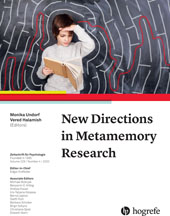Experience Matters
Effects of (In)Congruent Prompts About Word Frequency on Judgments of Learning
Abstract
Abstract. The present study tested if word frequency effects on judgments of learning (JOLs) are exclusively due to beliefs or if the direct experience with the items also plays a role. Across four experiments, participants read prompts about the frequency of the words (high/low), which could be congruent/incongruent with the words’ actual frequency. They made pre-study JOLs (except Experiment 1b), immediate JOLs, and completed a recall test. If experience drives the effect, JOLs should be based on actual word frequency rather than the prompts. Results showed higher pre-study JOLs for prompts of high frequency, but higher immediate JOLs for high-frequency words regardless of the prompt, suggesting an effect of direct experience with the words. In Experiments 2 and 3, we manipulated participants’ beliefs, finding a small effect of beliefs on JOLs. We conclude that, regarding word frequency, direct experience with the items seems more relevant than beliefs when making immediate JOLs.
References
(1989). Memory predictions are based on ease of processing. Journal of Memory and Language, 28(5), 610–632. https://doi.org/10.1016/0749-596X(89)90016-8
(2003). Predicting and postdicting the effects of word frequency on memory. Memory & Cognition, 31(2), 297–305. https://doi.org/10.3758/BF03194388
(2015). Delineating the effect of semantic congruency on episodic memory: The role of integration and relatedness. PLoS One, 10(2), e0115624. https://doi.org/10.1371/journal.pone.0115624
(2016). Picture-perfect is not perfect for metamemory: Testing the perceptual fluency hypothesis with degraded images. Journal of Experimental Psychology: Learning, Memory, and Cognition, 24(9), 1417–1433. https://doi.org/10.1037/xlm0000246
(2018). On belief and fluency in the construction of judgments of learning: Assessing and altering the direct effects of belief. Acta Psychologica, 186, 27–38. https://doi.org/10.1016/j.actpsy.2018.04.004
(2018). The word frequency effect in word processing: An updated review. Current Directions in Psychological Science, 27(1), 45–50. https://doi.org/10.1177/0963721417727521
(2007). G*Power 3: A flexible statistical power analysis program for the social, behavioral, and biomedical sciences. Behavior Research Methods, 39, 175–191. https://doi.org/10.3758/BF03193146
(2020). Does word frequency influence judgments of learning (JOLs)? A meta-analytic review. Canadian Journal of Experimental Psychology/Revue Canadienne de Psychologie Expérimentale. Advance online publication. https://doi.org/10.1037/cep0000206
(2017). More than just beliefs: Experience and beliefs jointly contribute to volume effects on metacognitive judgments. Journal of Experimental Psychology: Learning, Memory, and Cognition, 43(5), 680–693. https://doi.org/10.1037/xlm0000332
(2017). The influences of valence and arousal on judgments of learning and on recall. Memory & Cognition, 45(1), 121–136. https://doi.org/10.3758/S13421-016-0646-3
(2015). How much do metamemory beliefs contribute to the font-size effect in judgments of learning? PLoS One, 10(11), e0142351. https://doi.org/10.1371/journal.pone.0142351
(2016). The effect of word frequency on judgments of learning: Contributions of beliefs and processing fluency. Frontiers in Psychology, 6, Article 1995. https://doi.org/10.3389/fpsyg.2015.01995
(1997). Monitoring one’s own knowledge during study: A cue utilization approach to judgments of learning. Journal of Experimental Psychology: General, 126(4), 349–370. https://doi.org/10.1037/0096-3445.126.4.349
(2004). Predicting one’s own forgetting: The role of experience-based and theory-based processes. Journal of Experimental Psychology: General, 133(4), 643–656. https://doi.org/10.1037/0096-3445.133.4.643
(2019). Words in larger font are perceived as more important: Explaining the belief that font size affects memory. Memory, 27(4), 555–560. https://doi.org/10.1080/09658211.2018.1529797
(2019). Word frequency effects on judgments of learning: More than just beliefs. The Journal of General Psychology. Advance online publication. https://doi.org/10.1080/00221309.2019.1706073
(2014). The font-size effect on judgments of learning: Does it exemplify fluency effects or reflect people’s beliefs about memory? Journal of Memory and Language, 70, 1–12. https://doi.org/10.1016/j.jml.2013.09.007
(2017). How beliefs can impact judgments of learning: Evaluating analytic processing theory with beliefs about fluency. Journal of Memory and Language, 93, 245–258. https://doi.org/10.1016/j.jml.2016.10.008
(2017). Examining what prestudy and immediate judgments of learning reveal about the bases of metamemory judgments. Journal of Memory and Language, 94, 177–194. https://doi.org/10.1016/j.jml.2016.12.003
(2016).
Judgments of learning: Methods, data, and theory . In J. DunloskyS. TauberEds., The Oxford handbook of metamemory (pp. 90–117). Oxford University Press. https://doi.org/10.1093/oxfordhb/9780199336746.013.4(2008). Memory predictions are influenced by perceptual information: Evidence for metacognitive illusions. Journal of Experimental Psychology: General, 137(4), 615–625. https://doi.org/10.1037/a0013684
(1998). Comparing naming, lexical decision, and eye fixation times: Word frequency effects and individual differences. Memory & Cognition, 26(6), 1270–1281. https://doi.org/10.3758/BF03201199
(1974). Memory for words recently classified. Memory & Cognition, 2(1), 47–52. https://doi.org/10.3758/BF03197491
(2017). The Minho Word Pool: Norms for imageability, concreteness, and subjective frequency for 3,800 Portuguese words. Behavior Research Methods, 49(3), 1065–1081. https://doi.org/10.3758/s13428-016-0767-4
(2014). Procura-PALavras (P-PAL): Uma nova medida de frequência lexical do Português Europeu contemporâneo. Psicologia: Reflexão e Crítica, 27(1), 110–123. https://doi.org/10.1590/s0102-79722014000100013
(2016).
Metamemory and education . In J. DunloskyS. TauberEds., The Oxford handbook of metamemory (pp. 197–215). Oxford University Press. https://doi.org/10.1093/oxfordhb/9780199336746.013.6(2015). The effect of motoric fluency on metamemory. Psychonomic Bulletin & Review, 22(4), 1014–1019. https://doi.org/10.3758/s13423-014-0768-1
(2020). Cue integration in metamemory judgements is strategic. The Quarterly Journal of Experimental Psychology, 73(4), 629–642. https://doi.org/10.1177/1747021819882308
(2015). The relatedness effect on judgments of learning: A closer look at the contribution of processing fluency. Memory & Cognition, 43(4), 647–658. https://doi.org/10.3758/s13421-014-0479-x
(2019). Metamemory and memory for a wide range of font sizes: What is the contribution of perceptual fluency? Journal of Experimental Psychology: Learning, Memory, and Cognition, 45(1), 97–109. https://doi.org/10.1037/xlm0000571
(2017). Perceptual fluency contributes to effects of stimulus size on judgments of learning. Journal of Memory and Language, 92, 293–304. https://doi.org/10.1016/j.jml.2016.07.003
(2018). Perceptual fluency affects judgments of learning: The font size effect. Journal of Memory and Language, 99, 99–110. https://doi.org/10.1016/j.jml.2017.11.005



